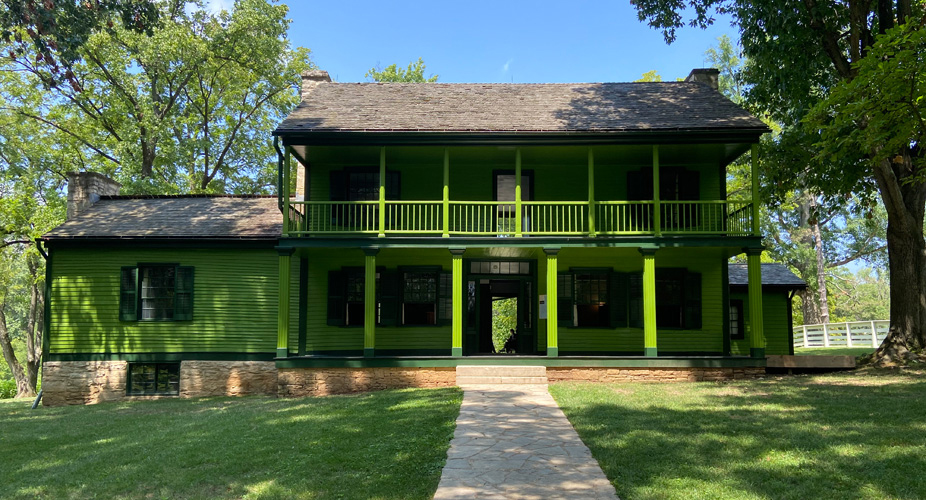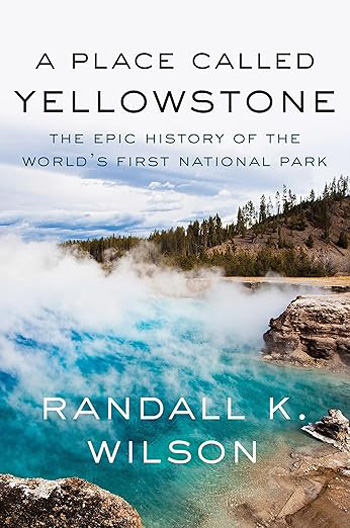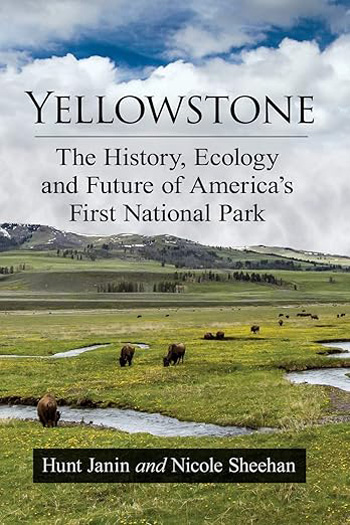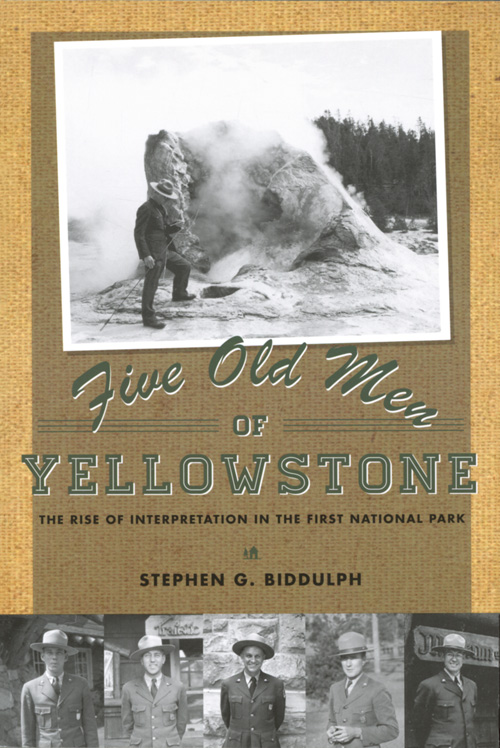|
National Park Service History Electronic Library & Archive
The NPS History Electronic
Library & Archive is a portal to electronic publications covering the history of
the National Park Service (NPS) and the cultural and natural history of the national
parks, monuments, and historic sites of the (U.S.) National Park System. Also included
are documents for national monuments managed by other federal agencies, along with a
collection of U.S. Forest Service publications.
The information contained in this Website is historical in scope and is
not meant as an aid for travel planning; please refer to the official
NATIONAL
PARK SERVICE Website for current/additional information. While we are not affiliated
with the National Park Service, we gratefully acknowledge the contributions
by park employees and advocates, which has enabled us to create this free
digital repository.
New eLibrary Additions
The Farm on the Gravois: Historic Structures Report (Main House, Stone Building, Barn, Other Structures), Ulysses S. Grant National Historic Site, St. Louis, Missouri (Alan W. O'Bright and Kristen R. Marolf, 1999)
Ethnographic Overview and Assessment, Stones River National Battlefield (William Leggett, Ida Fadzillah, Rebecca Conard and Pat Cummins, May 2016)
The Olmsted National Historic Site and the Growth of Historic Landscape Preservation 1979-2004 (©David Grayson Allen, 2005)
John Brown's Raid (William C. Everhart and Arthur L. Sullivan, 1973, reprint 1990)
Historic Structure Report: The Steeple Building, Christiansted National Historic Site (Quinn Evans and VHB, May 2024)
Historic Structure Report: Fort Christiansvaern and Stable Building: Volume 1 (Jospeh K. Oppermann-Architect, 2023)
Historic Structure Report: Fort Christiansvaern and Stable Building: Volume 2 (Jospeh K. Oppermann-Architect, 2023)
Historic Structure Report: 417-419 Decatur Street, Jean Lafitte National Historical Park and Preserve (Quinn Evans and VHB, May 2024)
Isle Royale - Primeval Prince: A History (D. Robert Hakala, May 1953, rev. May 1955)
A History of Richmond National Battlefield Park (John T. Willett, 1957)
Administrative History of Fire Island National Seashore (Betty Thompson, June 1977)
Longfellow National Historic Site: A Preservation History (Dwight T. Pitcaithley, April 1986)
A Brief History of Grand Teton National Park (Carl E. Jepson, 1952)
Cultural Landscape Report for Brandywine Valley, First State National Historical Park: Final Parts I and II (Brenda Williams, Megan Zidar, Dustin Smith, Adjoa Kennedy, Rebecca Huffman and Rebekah Lawrence, November 2024)
Cultural Landscape Report for Five Forks Battlefield, Richmond National Battlefield Park: Site History, Existing Conditions, Analysis and Evaluation Olmsted Center for Landscape Preservation (Wiss, Janney, Elstner Associates, Inc. Liz Sargent HLA and Historical Research Associates, Inc., March 2024)
Historic Landscape Assessment 2017, Faraway Ranch Orchard, Chiricahua National Monument, Arizona (Nicholas M. Hlatky, March 2018)
Furnishing Study: Commanding Officer's Quarters, Fort Davis, Texas (Benjamin Levy, January 15, 1968)
Historic Furnishings Report: Lindenwald, Martin Van Buren National Historic Site, New York (Carol E. Kohan, 1986)
Video: Walt Dabney at NAI 2016 (2016, Duration: 41:35)
Kanaka Village/Vancouver Barracks 1974 Institute of Environmental Studies Reports in Highway Archaeology No. 3 (David H. Chance and Jennifer V. Chance, 1976)
Report of Investigations of Excavations at Kanaka Village, Vancouver Barracks, Washington, 1980/1981: Volume 1 (Bryn Thomas and Charles Hibbs, Jr., Washington State Department of Transportation, 1984)
Report of Investigations of Excavations at Kanaka Village, Vancouver Barracks, Washington, 1980/1981: Volume 2 (Bryn Thomas and Charles Hibbs, Jr., Washington State Department of Transportation, 1984)
Excavation of Mound 7, Gran Quivira National Monument, New Mexico Publications in Archeology No. 16 (Alden C. Hayes et al., 1980)
Contributions to Gran Quivira Archeology Publications in Archeology No. 17 (Alden C. Hayes et al., 1981)
Civil War Battlefields, Shenandoah Valley, Virginia (August 1993)
Annual Mountaineering Summary: 2024, Denali National Park and Preserve
Newsletter: Buckeye National Scenic Trail Feasibility Study (January 2025)
Cultural Landscapes Inventory Professional Procedures Guide (Craig Somers, 2025)
Historic Structures Inventory Professional Procedures Guide (Craig Somers, 2025)
Paleontological Resource Inventory (Public Version), Effigy Mounds National Monument NPS Science Report NPS/SR-2025/230 (Justin S. Tweet and Vincent L. Santucci, January 2025)
A Review of the Effects of Climate Change on Visitor Use in US Public Lands and Waters NPS Science Report NPS/SR-2025/231 (Emily J. Wilkins, Sarah Rappaport, Wylie Carr, Julianne Reas, Samantha G. Winder and Spencer A. Wood, January 2025)
Landscape Phenology, Vegetation Condition, and Relations with Climate at Curecanti National Recreation Area, 2000-2019 NPS Science Report NPS/SR-2025/219 (David Thoma, January 2025)
Surficial Geology and Proglacial Lake Change at Sít' Tlein (Malaspina Glacier), Wrangell-St. Elias National Park and Preserve, Alaska NPS Natural Resource Repport NPS/WRST/NRR-2024/2620 (Anna C. Thompson, Michael G. Loso, Sydney A. Mooneyham, Brandon S. Tober, Christopher F. Larsen and John W. HOlt, January 2024)
Assessing giant sequoia mortality and regeneration following high-severity wildfire (David N. Soderberg, Adrian J. Das, Nathan L. Stephenson, Marc D. Meyer, Christy A. Brigham and Joshua Flickinger, extract from Ecosphere, 2024)
Classification and clustering analysis of standing dead trees and associated park asset wildfire vulnerability in Yellowstone National Park (Carolyn Prescott, Mehmet Ozdes and Di Yang, extract from Forest Ecosystems, Vol. 12, 2025)
The Giants of Sequoia and Kings Canyon (Howard R. Stagner, 1958)
Park Science (Vol. 39 No. 1, Winter 2024-2025)
Crater Lake Nature Notes/Nature Notes from Crater Lake (1928-1938, 1946-1956, 1992-2001)
Glacial Drift: Nature Notes from Glacier National Park (1927-1938)
Nature Notes of Grand Canyon (1926-1935, 2007-2008)
Grand Teton Nature Notes (1935-1941)
Mount Rainier National Park Nature Notes (1923-1939, 1984-1989)
Yellowstone Nature Notes (1920-1960)
Zion-Bryce Nature Notes (1929-1936, 2009-2011)
1993 HABS/HAER Review
Identification of Historic Properties: A Decisionmaking Guide for Managers (September 1988)
Rectified Photography and Photo Drawings for Historic Preservation (J. Henry Chambers, December 1973)
Second Lives: A Survey of Architectural Artifact Collections in the United States (Emogene A. Bevitt, 1994)
Moisture Problems in Historic Masonry Walls: Diagnosis and Treatment (Baird M. Smith, 1984)
Third Annual Historic Structures Training Conference: Early American Brick Masonry and Restoration of Exterior Brick Walls (August 9, 1963)
Directory of Historic Preservation Easement Organizations (Charles E. Fisher, William G. Macrostie and Christopher A. Sowick, comps., September 1981)
The Proposed James Island Bridge, Charleston, South Carolina (January 1971)
Identifying, Evaluating, and Documenting Traditional Cultural Places National Register Bulletin (Sherry A. Frear, ed., 2024)
National Register of Historic Places and National Historic Landmarks: 2024 Year in Review
Record of Decision Approved Resource Management Plan: Bears Ears National Monument, San Juan County, Utah (BLM, January 2025)
Record of Decision and Approved Plan Amendment for the Manti-La Sal National Forest Land and Resource Management Plan / Bears Ears National Monument Resource Management Plan (USFS, January 2025)
A National Plan for American Forestry: Volume I Letter from the Secretary of Agriculture Transmitting in Response to S. Res. 175 (Seventy-Second Congress) the Report of the Forest Service of the Agriculture Department on the Forest Problem of the United States (Senate Document No. 12, 73d Congress 1st Session, 1933)
A National Plan for American Forestry: Volume II Letter from the Secretary of Agriculture Transmitting in Response to S. Res. 175 (Seventy-Second Congress) the Report of the Forest Service of the Agriculture Department on the Forest Problem of the United States (Senate Document No. 12, 73d Congress 1st Session, 1933)
The Western Range Letter from the Secretary of Agriculture Transmitting in Response to Senate Resolution No. 289, A Report on the Western Range—A Great But Neglected Natural Resource (Senate Document 199, 74th Congress 2d Session, 1936)
NPS Reflections
|
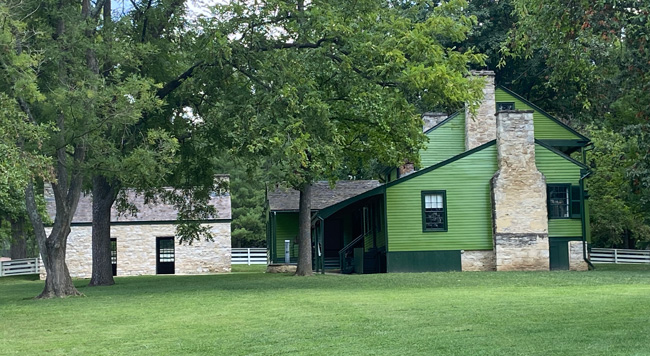
White Haven
Early European American settlement of land overlooking Gravois Creek
that would later become part of White Haven farm was acquired in 1796 by
Hugh Graham. Graham’s tract, which measured approximately 800 arpents
(roughly 675 acres), was acquired from the Spanish government. Graham
made few improvements to the property and on September 6, 1799, deeded
the property to Jacques (who was also known as James) Mackay in exchange
for land on the Missouri River. By 1808, Jacques Mackay had sold a
portion of the tract to his brother-in-law, William L. Long. It was Long
who built the first dwelling on the property.
In 1808, Long married Elizabeth Sappington, daughter of John
Sappington, a Revolutionary War veteran and prominent early settler of
the region. The couple initially lived in a cabin on the property while
Long began to build a more commodious dwelling in 1816. Long, however,
never completed the dwelling, but rather sold the property to Theodore
Hunt. It was Hunt who completed the structure in 1818. The Hunts
remained at White Haven until 1820, when they sold the property to
“Colonel” Frederick Dent, a businessman from St. Louis. The sale was
completed in 1821.
White Haven initially served as a summer home for Frederick Fayette
Dent and his wife Ellen Wrenshall Dent while Frederick continued to
operate his business in the city. As the Dent family grew, Frederick
decided to relocate to the country property because White Haven offered
both more space for the family and the opportunity for him to invest his
energies in farming, which he enjoyed more than mercantile life. [4] The
Dents moved to the property full-time in 1827. Frederick Dent named the
property White Haven based on another family property located in
Maryland. The Dents had eight children, one of whom died in infancy.
Julia Dent, who would later marry Ulysses S. Grant, was the fifth child
and oldest daughter. The other children were named John, George,
Frederick, Louis, Ellen, Mary, and Emily (who was known as Emma).
The Dent’s third son, Frederick Tracy Dent, graduated from West Point
in 1843. Among his classmates was Hiram Ulysses Grant, who had
mistakenly been listed on his registration paperwork by the Congressman
from his area, Thomas Hamer, as “Ulysses S. Grant.” After graduating,
Grant was assigned to Jefferson Barracks, located south of the city of
St. Louis, and 5 or 6 miles from White Haven. Frederick Dent likely
extended an invitation to Grant to visit White Haven during their final
year at West Point, after Grant received his assignment with the 4th
U.S. Infantry. It was through one of his visits that Grant met Julia
Dent in February 1844. Upon learning of his company’s impending transfer
out of St. Louis in May 1844, Grant asked Julia to marry him. The couple
would endure a four-year engagement while Grant was stationed in
Louisiana and Texas for several years before the Mexican American War
began in 1846, and then spent time in Mexico during the war. The Grants
were married on August 22, 1848, at the Dent’s city home in St. Louis at
Fourth and Cerre Streets while Grant was afforded a two-month leave of
absence at the conclusion of the war.
Following the wedding, the Grants went on a honeymoon, and were in
Detroit by November 1848 for Grant’s subsequent army assignment. They
stayed in the St. Louis area and at White Haven for a brief time before
heading to Detroit. The Grants were later transferred to an army post in
New York after Michigan. While Julia accompanied Grant to these posts,
she returned to White Haven in 1850 for the birth of their first of four
children, Frederick Dent Grant. When Grant was stationed in California
in 1852, Julia moved to White Haven to be with her family. On the way
back to White Haven, Julia gave birth to the Grant’s second child,
Ulysses Jr., while traveling through Ohio.
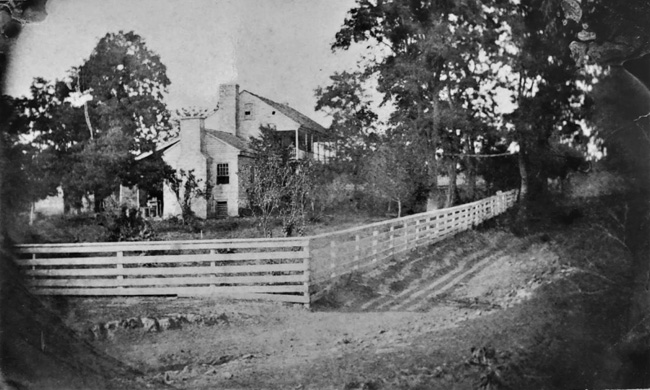
The earliest known photograph of White Haven, ca. 1860,
shows the Main House, a white board fence surrounding the dwelling
precinct, and several large shade trees and other plantings. (Ulysses S.
Grant National Historic Site archives)
In the summer of 1854, Grant resigned from the army and returned to
settle down with his wife, children, and in-laws at White Haven. The
Grants initially lived in the Main House at White Haven. By July 1855,
the couple was living in Wish-ton-Wish, a cottage belonging to Julia’s
brother Louis that was located about a half mile to the south of the
White Haven Main House. After Grant completed construction of a log
cabin that became known as Hardscrabble on an 80-acre property, located
1 mile to the north, which had been given to Julia by her father as a
wedding gift in 1848, the couple relocated to the home.
Julia’s mother died a few months after they moved into Hardscrabble.
Frederick Dent moved to his city home following his wife’s death as
Ulysses assumed responsibility for overall management of the White Haven
property. Grant’s primary objective was to make a concerted effort to
make the farm profitable. After moving back into the house at White
Haven, Grant leased Hardscrabble to tenant farmers, while helping farm
the 200 acres of cultivated land already in production by his
father-in-law. Due to a poor year for crops in 1857 and a nationwide
depression that year, followed by poor weather conditions in 1858, Grant
found that farming at White Haven could not meet his financial needs. In
the fall of 1858, he auctioned off his livestock and farm implements and
rented out the fields. In January 1859, Grant began to work in town with
a Dent cousin, Harry Boggs, as part of a real estate partnership. While
he worked in St. Louis during the week, he traveled back to White Haven
every weekend until March, at which time Julia and the children joined
him in town. Unfortunately, Grant also found it difficult to be
successful as a bill collector and soon gave up on the real estate
partnership. While in St. Louis, Grant visited the St. Louis Courthouse
on March 29, 1859, and wrote a manumission paper legally freeing William
Jones from slavery. Jones is considered to have been the last enslaved
person owned by a U.S. president. [5] Grant also applied, unsuccessfully,
for the position of St. Louis County Engineer, and briefly worked at the
U.S. Customshouse. During this period, the Grants moved into two
additional residences.
In 1860, the Grants left St. Louis so Ulysses could work for his
father’s leather goods store in Galena, Illinois. At the outbreak of the
Civil War in 1861, he offered his services to the Governor of Illinois
to command the 21st Illinois Volunteers. Grant’s importance to the
outcome of the Civil War is legendary, and would later lead to his being
elected President of the U.S.
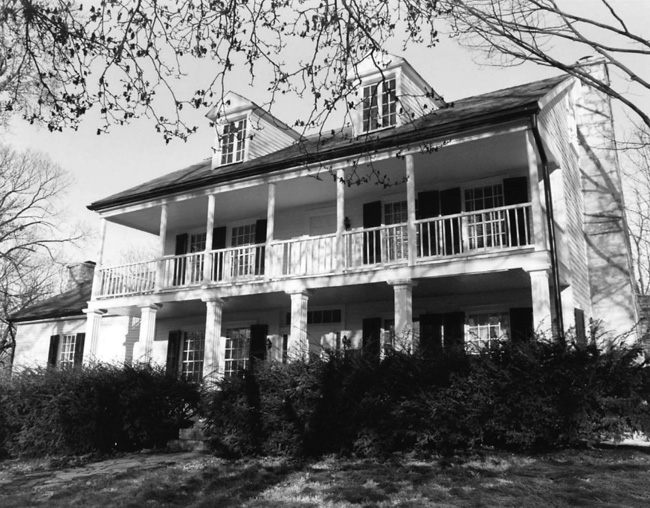
Photograph, looking west, showing the front of the Main
House at White Haven, 1990. Save White Haven. (Ulysses S. Grant National
Historic Site Archival Collection, St. Louis)
Although Grant never again lived in St. Louis, he visited often.
Around 1865, he began to purchase parcels of the Dent property and
divided them among members of the family. By 1868, as he became the
Republican nominee for U.S. President, Grant had acquired much of the
original Dent property. Planning for his eventual retirement, Grant
instructed his farm manager to build a large horse barn and to acquire
some stock, intending to return to Missouri when his public duty was
over and raise horses. Grant remained in office until 1877, after which
he and Julia began a world tour. They did not return to live at White
Haven, however, but instead moved to New York based on the fact that the
farm was not financially sustainable. Three of the Grant’s four children
were also living in New York City when they returned to the United
States, suggesting that they also wanted to be close to family.
Son Ulysses Jr. became involved in a banking venture in New York with
a partner, forming the firm of Grant and Ward. Ulysses Sr. received a
loan for $150,000 from William Henry Vanderbilt in order to provide a
personal loan to Ward. White Haven was used as partial collateral on the
personal loan. When the firm went bankrupt on May 6, 1884, Ward fled the
country with the loan. Grant insisted on repaying the debt even though
Vanderbilt offered a number of alternatives. Grant eventually turned
over all of his and Julia’s real property, with the exception of their
New York house, as well as a great deal of memorabilia to satisfy his
personal debt to Vanderbilt. White Haven was valued at $60,000 in the
transaction that resulted in 646 acres of White Haven being transferred
to Vanderbilt on April 15, 1885. A few months later, on July 23, 1885,
Grant died of throat cancer.
In 1888 Vanderbilt sold the property to Luther H. Conn, a real estate
agent in St. Louis. Conn used the property as a summer house which he
called “Grant Wood.” Adolphus Busch acquired a 213-acre parcel from Conn
in 1903 and moved Grant’s Hardscrabble log cabin to this parcel. The log
cabin remains standing in this location today. Busch used his land to
establish an elaborate estate which he called “Grant’s Farm.” In 1905,
Conn sold 15 acres surrounding the Main House to a development company,
which planned to build an amusement park, intending to capitalize on the
associations of the property with Grant and its location immediately
adjacent to the station of the Carondelet and Kirkwood Branch of the
Missouri Pacific Railroad. White Haven was saved from this fate by
Albert Wenzlick, another St. Louis realtor, who received the property by
foreclosure in 1913 along with 105 adjacent acres, establishing a
property totaling 160 acres.
Like Conn before him, Wenzlick used the Main House primarily during
the summer. He updated the property by adding electricity and plumbing,
as well as recreational features and amenities and plantings. Albert
Wenzlick died in 1937. The property was inherited by his son Delbert,
who decided to make White Haven his permanent home in 1940. That year he
had the Main House and adjacent buildings recorded by the Historic
American Buildings Survey, and then proceeded to make careful repairs
and alterations to the property. Wenzlick also subdivided the property
and in the 1950s and 1960s, the surrounding pastures were platted and
developed with suburban ranch houses. [6]
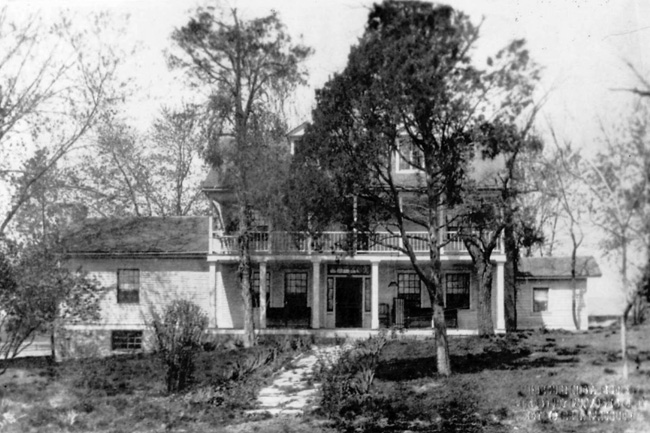
Photograph, looking northwest, showing the front of the
Main House at White Haven, 1927. (Ulysses S. Grant National Historic
Site Archival Collection, St. Louis)
Delbert Wenzlick began exploring the possibility of selling the
property in the 1970s. Wenzlick understood the historical value of the
White Haven property and was interested in possibly selling it to a
public entity such as St. Louis County Parks to serve as a public
amenity. Delbert Wenzlick passed away shortly after beginning
discussions with St. Louis County Parks in January 1979 regarding the
future of White Haven. Soon after his death, Delbert’s son, Bill
Wenzlick, signaled his willingness to either sell the property to a
preservation group or consider offers from developers due to his
financial liability in retaining ownership. In the meantime, a
representative of St. Louis County Parks, Esley Hamilton, began to
research the history of the property and preparation of a National
Register nomination as a way to encourage preservation. His work led to
the property being listed in the National Register on April 3, 1979.
Hamilton also later prepared documentation seeking National Historic
Landmark (NHL) designation for White Haven. Despite these recognitions,
Wenzlick continued to explore the potential for the property to undergo
development, indicating in 1985 that he had reached out to the
Anheuser-Busch brewing company about a possible sale. [7]
To address the ongoing threat, preservation advocates established
“Save Grant’s White Haven, Inc.” in 1985. The group promoted the idea of
public ownership that would lead to protection of the property.
Expressing interest in the property were the Missouri State Parks
department and the National Park Service. Meeting to discuss purchasing
options in March 1985 were Wayne Kennedy, Director of St. Louis County
Parks, John Karel, Director of Missouri State Parks, and Jerry Schober,
Superintendent of Jefferson National Expansion Memorial (now Gateway
Arch National Park). [8] Also during this period, National Park Service
Chief Historian Edwin C. Bearss visited White Haven to determine its
potential for inclusion in the National Park System and prepared a study
completed in 1986.
As a result of the advocacy promoted by Save Grant’s White Haven,
Inc., which included fund raising, designing public programming to
educate local residents about the history of the property, and
soliciting support from county, state, and federal agencies, St. Louis
County purchased the property for $510,000 from the Wenzlicks in 1986. A
portion of the funds for the acquisition were provided in the form of a
loan by the Missouri Department of Natural Resources, while the
remainder was raised through issuance of a county bond. Following the
purchase, White Haven was jointly owned and cared for by St. Louis
County and the State of Missouri. [9] In 1986, White Haven was designated
an NHL; a plaque was unveiled at the house to commemorate the listing in
1989.
The county and state continued to jointly manage the property through
the 1980s. On October 2, 1989, President George H.W. Bush signed
legislation authorizing the establishment of Ulysses S. Grant National
Historic Site. This modified an earlier proposal to name the property
“White Haven National Historic Site.” St. Louis County Parks transferred
ownership and management of the property to the National Park Service
once Jefferson National Expansion Historical Association paid off the
remaining debt on the property. White Haven has been extensively
restored and rehabilitated to its 1875 appearance since the National
Park Service assumed administrative responsibility for the property.
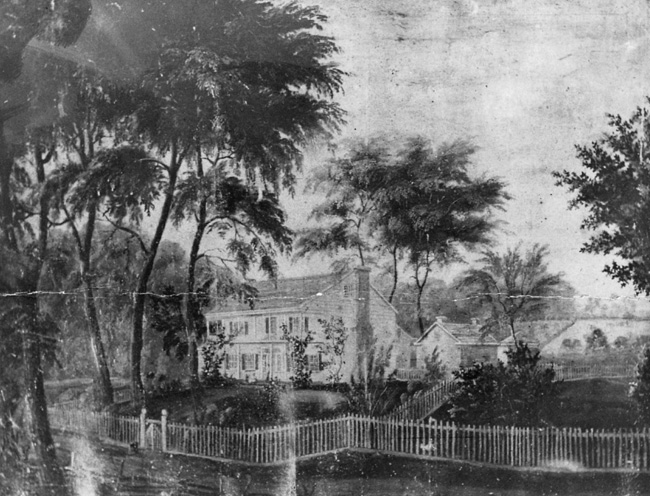
"White Haven, the House in Which and Where I Was Born
— August 29, 1816." Photography of a ca. 1880 albumen print of a
ca. 1840 painting of White Haven. (Missouri Historical
Society)
Endnotes
4 Julia Dent Grant, The Personal Memoirs of Julia Dent
Grant [Mrs. Ulysses S. Grant], J. John W. Simon, ed. (New York: G. P.
Putnam’s Sons, 1975), 42–43.
5 National Park Service, “William Jones, Ulysses S Grant
National Historic Site,” https://www.nps.gov/people/william-jones.htm
(accessed January 28, 2024).
6 National Park Service, “White Haven Cultural Landscape
Report,” 3–5.
7 Nick Sacco, “Historic Preservation From the Grassroots:
A History of Save Grant’s White Haven,” Ulysses S. Grant National
Historic Site Missouri,
https://www.nps.gov/ulsg/learn/historyculture/the-story-of-save-grant-s-
whitehaven. htm (accessed January 28, 2024).
8 Sacco, “Historic Preservation From the Grassroots.”
9 National Park Service, Ulysses S. Grant National
Historic Site Long-Range Interpretive Plan (2011), 3.
Text from Cultural Landscape Report: White Haven, Ulysses S. Grant National Historic Site, Raths, Raths & Johnson, July 2024.
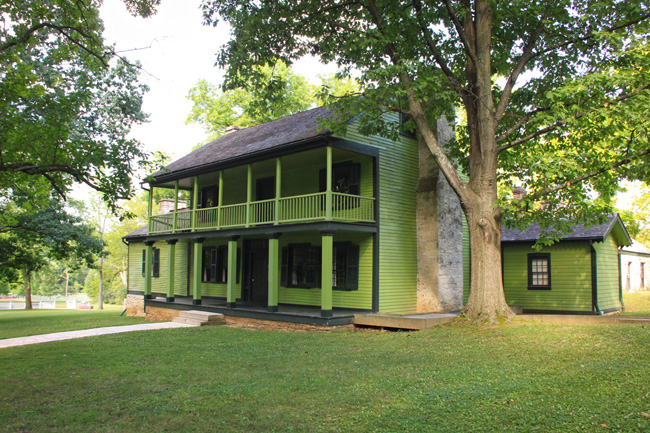
White Haven, 2016. (National Park Service)
|
National Park Friends
|
Please Note: NPSHistory.com is an independent effort; we are not an
official partner of the National Park Service (NPS), though a
huge debt of gratitude is extended to all NPS employees (current
and former) and other park supporters who have graciously contributed
their personal collections, thus enabling us to present these rather
scarce documents for free public use. Due diligence has been employed in
scanning these documents in an attempt to ensure the accuracy of the
materials presented, however, we make no representations or warranties
of any kind about these digital documents. While most of the content
contained herein is in the public domain, the Website also contains
copyrighted works (permission to host this content is on file); please
respect the reserved rights of these copyright-holders. Use of this
Website is done so at your own risk; we are not responsible for
any loss or damage arising from information or links contained within
this site. Enjoy!
|
|

